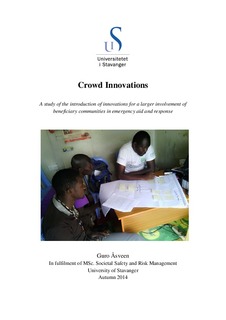| dc.contributor.author | Åsveen, Guro | |
| dc.date.accessioned | 2015-03-13T13:40:42Z | |
| dc.date.available | 2015-03-13T13:40:42Z | |
| dc.date.issued | 2014-12 | |
| dc.identifier.citation | Åsveen, G. (2014) Crowd Innovations : a study of the introduction of innovations for a larger involvement of beneficiary communities in emergency aid and response | nb_NO |
| dc.identifier.uri | http://hdl.handle.net/11250/279190 | |
| dc.description | Master's thesis in Risk management and societal safety | nb_NO |
| dc.description.abstract | With data from crisis-mapping specialists and emergency response agencies in Nairobi, Kenya, this thesis studies the challenges and potentials in diffusion and implementation of crowd innovations. The term, crowd innovations, is used to describe concepts such as crowdsourcing, crowdseeding and crowdfeeding, which builds on the idea that the public and beneficiary populations can extend their contributions to humanitarian and emergency responders through peer production and consumption of information. This idea is central to the emerging field of crisis mapping.
In this thesis, a three level diffusion/implementation model is presented and applied in the analysis of how crowd innovations spread (diffusion) and are put into use (implementation). The first level addresses the diffusion dialogue between the crisis-mapping specialists and individual users (non-organisational adopters). The second level addresses the diffusion dialogue between the crisis-mapping specialists and the managers of relevant organisations (organisational adopters), while the third level addresses the implementation dialogue between the organisational managers and the lower-level members of the organisation (organisational adopters). A purpose of this model is to highlight the tech-specialists choice to diffuse to individuals that can serve as a member of a crowd directly, or diffuse to and through relevant organisations and their managers.
The findings suggest that there are several overlapping challenges facing diffusion at different levels. These include, for example, insufficient capabilities (lack of technical skills, training, equipment etc.), mistrust in crowd-generated data and lack of knowledge about long-term consequences of adopting crowd innovations. At the same time, early involvement of well-established organisational adopters could potentially power corrective actions to overcome such challenges.
In line with these and other findings, the thesis concludes that the promotion of crowd innovation should to a larger extent recognise the value of diffusion via influential response organisations and their leaders. | nb_NO |
| dc.language.iso | eng | nb_NO |
| dc.publisher | University of Stavanger, Norway | nb_NO |
| dc.relation.ispartofseries | Masteroppgave/UIS-SV-IMKS/2014; | |
| dc.rights | Navngivelse 3.0 Norge | * |
| dc.rights.uri | http://creativecommons.org/licenses/by/3.0/no/ | * |
| dc.subject | samfunnssikkerhet | nb_NO |
| dc.subject | societal safety | nb_NO |
| dc.subject | risk management | nb_NO |
| dc.subject | humanitarian technology | nb_NO |
| dc.subject | crisis mapping | nb_NO |
| dc.subject | crowd sourcing | nb_NO |
| dc.subject | crowdseeding | nb_NO |
| dc.subject | diffusion | nb_NO |
| dc.subject | adopters | nb_NO |
| dc.subject | Kenya | nb_NO |
| dc.subject | Red Cross | nb_NO |
| dc.subject | Røde Kors | nb_NO |
| dc.subject | emergency communication and response | nb_NO |
| dc.subject | nødhjelp | nb_NO |
| dc.title | Crowd Innovations : a study of the introduction of innovations for a larger involvement of beneficiary communities in emergency aid and response | nb_NO |
| dc.type | Master thesis | nb_NO |
| dc.subject.nsi | VDP::Social science: 200 | nb_NO |
| dc.source.pagenumber | 119 | nb_NO |

